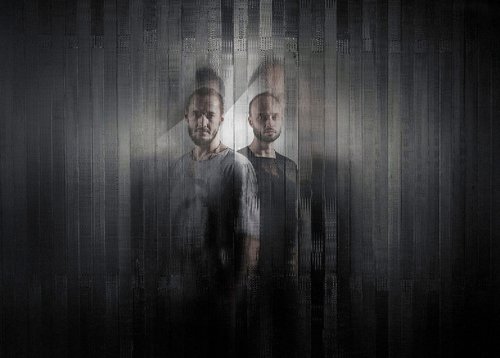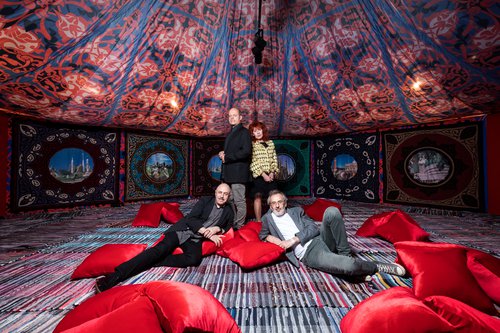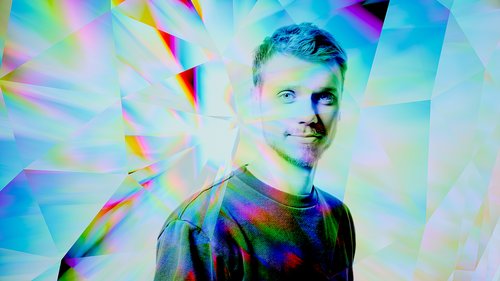Diana Artemeva. Active Worlds. Courtesy of the artist
Game-Art: Mapping the Digital Psyche
Video games can be effective communication tools through which to explore existential issues, social injustices, and collective anxieties in immersive adventures. Born during the era of transmedia convergence, they synthesize architecture, painting, cinema, literature, and music, offering us a new dimension: interactive engagement. These digital playgrounds have facilitated events like the reimagining of the Russian Pavilion at the Giardini della Biennale in Venice and artistic interventions within Minecraft or The Sims 4, and are redirecting our approaches to creative expression itself.
Can computer games be considered art? Certainly, they occupy a liminal position between media art and the attractions of the entertainment industry to which they are constantly pulled by strong commercial forces (the global gaming community comprises over three billion people today). In 2023, the Serpentine Gallery in London presented ‘Third World: The Bottom Dimension’ by Brazilian artist Gabriel Massan (b. 1996) alongside a Web3 game that combines commentary about social inequality with play-to-earn mechanics and is often critiqued as a semi-scam model. Within the virtual space of digital sculptures, players are encouraged to create screenshots that generate NFTs on the Tezos platform, which can then be traded or exchanged with others.
Positioning video games in the artistic canon requires a reevaluation of aesthetic definitions. While American philosopher John Dewey defined art as a modality of communicative experience, video games introduce ‘procedural communication’ whereinteraction becomes an experiential form of engaging with art. Recognizing video games as art seems justified if only because it expands the boundaries of our understanding of the world. While most video games would not qualify as a work of art, it is certainly possible for a work of art to take the form of a video game.
A significant marker of institutional recognition for video games was their inclusion in MoMA’s applied design collection in 2012, with Pac-Man, The Sims, and Tetris among others. While Guardian journalist Jonathan Jones instantly protested, “Sorry, MoMA, video games are not art,” the museum had already laid the groundwork for gaming’s legitimacy two years earlier by featuring ‘Long March: Restart’ by Chinese artist Feng Mengbo (b. 1966).
Within the taxonomy of Game-art, a distinctive position is held by art-games or non-games – ambiguous software artifacts that jettison requirements for narrative, entertainment, and meaning, encouraging players to engage in pure contemplation – to experience virtual reality liberated from imperatives and reward structures.
Since 1998, the ideologues behind non-games – American Auriea Harvey (b. 1971) and Belgian Michaël Samyn (b. 1968) were experimenting with computer-based art before they established their influential studio ‘Tale of Tales’. Their seminal 2006 ‘Realtime Art Manifesto’ advocated to “embrace the abundance that the digital allows for,” […] “drop the requirement of making a game,” and “not rely on static renderings.”
Among their like-minded peers, Harvey and Samyn highlighted Ice-Pick Lodge, a Moscow-based studio, or, as its former director and founder Nikolay Dybowski called it, an “artistic association.” The manifestation of their artistic philosophy emerged in their debute work ‘Pathologic’ – less a conventional video game than a theatrical simulation of human behavior during an epidemic, executed with disturbing logic. In the absence of any interface elements on the screen, three characters can transgress game imperatives, challenge narrative constraints, and confront personal moral boundaries.
An example of how video games that offer interaction paradigms mirroring real-world dynamics, can function as social laboratories is ‘Roots’ by Ellina Gennadievna (b. 1989), a programmer-artist trained under new media pioneers Aristarkh Chernyshev (b. 1968) and Alexei Shulgin (b. 1963) at the Rodchenko School in Moscow. The project’s biosystem, created in collaboration with Maria Sviridova and Dmitry Kuznetzov, features dynamic tree roots controlled by a carbon dioxide sensor-equipped mask: when the player breathes in a state of calm it stimulates virtual roots growth, while arrhythmia triggers regression, fossilizing the system into a digital herbarium. This communion with an otherworldly environment appears to level the conditions of metaphysical parity, where online and offline events carry equivalent significance: intimate sensory relationships form between the agent of the physical world and virtual entities, synchronizing biological impulses with a technological response.
Last year, grappling with his fractured identity as a Russian-speaking artist who immigrated from Latvia to the USA, Viktor Timofeev (b.1984) designed ‘Agents and Boundaries’ where players have to cross a 3D space while simultaneously monitoring it from an elevated viewpoint. These two perspectives gradually splinter, occupied by agents and spatial prompts which exist in one perspective but not the other and players must reconcile them, mirroring the dissonance we experience when negotiating personalrelationships, national identities, and societal expectations.
In 2021, for the 17th Venice Architecture Biennale Ippolito Pestellini, curator of the Russian Pavilion, entrusted the reimagining of the historical building designed by Shshusev in 1914 at the Giardini to a new generation of artists. The pavilion underwent a digital transformation by Mikhail Maximov (b. 1974) becoming ‘Sanatorium Anthropocene Retreat,’ where an identity-fluid protagonist undergoes a sequence of mutations, drifts through bizarre interiors and gardens, looking for the temporal coordinates of the Anthropocene.
Initially, ‘Sanatorium Anthropocene Retreat’ was envisioned by Maximov as a virtual sanctuary for the Biennale’s curators and architects – a realm designed to abstract work-related interactions. Yet, under the restraints of the global pandemic, the project evolved into a more anxiety provoking cartography of posthuman existence. At the beginning of the game, a character attempts to communicate with an anthropomorphic entity but receives only the looped refrain: ‘I can talk with Humans and machines only.’
The Russian Pavilion at the 17th Venice Architecture Biennale also featured ‘Juha’s Nightmares’ by Yulia Kozhemyako (b.1985) a member of I.B.O.R.G. art collective. In this work a series of nightmares unfold in a disorienting domain of unrendered 3D. Within this dreamscape, players can get stuck in a texture or glimpse underlying polygonal networks and meshes; the digital environment pulses with glitches functioning as semantic amplifiers of the gaming experience. Like real dreams, ‘Juha’s Nightmares’ is not meant to be interpreted, demanding instead to be viscerally experienced.
Poet-musician IliaMazo, collaborating with developer sad3d aka Alexander Ignatov, also embraces the raw garage aesthetic of digital imperfection, deliberately rejecting photorealistic polish to highlight the immersive capacities that distinguish video games from other forms of expressive media. Their sandbox game ‘It’s Winter’ plunges players into a residential quarter steeped in post-Soviet aesthetics, where the micropoetics of everyday existence distill and transmit the complex emotional textures of ‘Russian khandra’ – a melancholy referenced in 19th-century literature.
Among the most visually and narratively arresting contemporary artists working with video games is British creator Danielle Brathwaite-Shirley (b. 1995). Her participatory works function as archives for stories of marginalized individuals, particularly those of the Black trans community – perspectives frequently flattened or disregarded. In ‘The Soul Station,’ exhibited at Halle am Berghain in 2024, Brathwaite-Shirley interlaces lived experience with speculative fiction to construct a utopian world free from societal oppressors, compelling players to confront their biases: “Bring your despair, fear, hopes, depression, excitement, tears, intolerance, joy, desperation, utopia, mistakes, anger, pain, pleasure; just bring yourself,” she writes in the prologue to the game.
As virtual interfaces became increasingly subsumed as passive functions of daily life, artists have been drawn to the medium’s potential for intervention. Two decades ago among the most radical exercises in digital minimalism was Cory Arcangel’s (b. 1978) modification of ‘Super Mario Bros.’ into the video installation ‘Super Mario Clouds.’ By stripping this iconic game of its rules, narrative structure, protagonist, and ancillary elements, Arcangel left only pixelized clouds drifting across a blue background. Presented at the Whitney Biennial in 2004, this gesture lowered interactivity to its minimal threshold within defined game parameters while substituting competitive engagement with aesthetic contemplation.
Diana Artemeva (b. 2000) leverages her understanding of game mechanics to engage in institutional critique, network activism, and conceptual exploration. Through her series of in-game photography in Active Worlds, she documents the behavior of sunlight as it interacts with objects, NPCs, and vegetation. In The Sims 4, Artemeva identifies a glitch that periodically generates floating plastic bags and places an easel nearby, instructing a character-artist named Be Laer to sketch the anomaly over several days. This experiment extends further in her project ‘Master of the Real,’ where she projects Be Laer into the physical space of Moscow’s Generative Gallery. Beyond interrogating the limits of algorithmic autonomy within predetermined parameters, Artemeva asks us to reflect: might a game avatar possess its own distinctive existence worthy of critical appreciation, capable of more than the purposes for which the user engage with the game environment?
While some virtuality theorists may indeed subscribe to the hypothesis that “we will continue our exodus to the virtual world,” as articulated by Edward Castronova, professor of media at Indiana University Bloomington and author of ‘Synthetic Worlds,’ what remains undeniable is that humanity as we know it has always been shaped by its habitat throughout history. Thus you see the fundamental significance of Game-art as a platform for reflecting on environmental changes in the digital age; its interactive parables, accessed through aesthetic curiosity, may in the end enable us to naively interpret the evolution of computer games as a repository of essential knowledge about the distinctive physical and psychological processes that define our time.

















